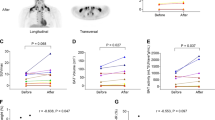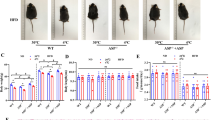Abstract
Obesity contributes to the progression of various chronic diseases, and shortens life expectancy. With abundant mitochondria, brown adipose tissue (BAT) dissipates energy through heat to limit weight gain and metabolic dysfunction in obesity. Our previous studies have shown that aurantio-obtusin (AO), a bioactive ingredient in Chinese traditional medicine Cassiae semen significantly improves hepatic lipid metabolism in a steatotic mouse model. In the current study we investigated the effects of AO on lipid metabolism in the BAT of diet-induced obesity mice and in oleic acid and palmitic acid (OAPA)-stimulated primary mature BAT adipocytes. Obese mice were established by feeding a HFHS diet for 4 weeks, and then administered AO (10 mg/kg, i.g.) for another 4 weeks. We showed that AO administration significantly increased the weight of BAT and accelerated energy expenditure to protect the weight increase in the obese mice. Using RNA sequencing and molecular biology analysis we found that AO significantly enhanced mitochondrial metabolism and UCP1 expression by activating PPARα both in vivo and in vitro in the primary BAT adipocytes. Interestingly, AO administration did not improve metabolic dysfunction in the liver and white adipose tissue of obese mice after interscapular BAT excision. We demonstrated that low temperature, a trigger of BAT thermogenesis, was not a decisive factor for AO to stimulate the growth and activation of BATs. This study uncovers a regulatory network of AO in activating BAT-dependent lipid consumption and brings up a new avenue for the pharmaceutical intervention in obesity and related comorbidities.

This is a preview of subscription content, access via your institution
Access options
Subscribe to this journal
Receive 12 print issues and online access
$259.00 per year
only $21.58 per issue
Buy this article
- Purchase on Springer Link
- Instant access to full article PDF
Prices may be subject to local taxes which are calculated during checkout








Similar content being viewed by others
References
Blüher M. Obesity: global epidemiology and pathogenesis. Nat Rev Endocrinol. 2019;15:288–98.
Piché ME, Tchernof A, Després JP. Obesity phenotypes, diabetes, and cardiovascular diseases. Circ Res. 2020;126:1477–500.
Haslam DW, James WP. Obesity. Lancet 2005;366:1197–209.
Reilly JJ, El-Hamdouchi A, Diouf A, Monyeki A, Somda SA. Determining the worldwide prevalence of obesity. Lancet. 2018;391:1773–4.
Kelly T, Yang W, Chen CS, Reynolds K, He J. Global burden of obesity in 2005 and projections to 2030. Int J Obes (Lond). 2008;32:1431–7.
Loos RJF, Yeo GSH. The genetics of obesity: from discovery to biology. Nat Rev Genet. 2022;23:120–33.
Fink J, Seifert G, Blüher M, Fichtner-Feigl S, Marjanovic G. Obesity surgery. Dtsch Arztebl Int. 2022;119:70–80.
Lidell ME, Enerbäck S. Brown adipose tissue–a new role in humans? Nat Rev Endocrinol. 2010;6:319–25.
Lidell ME, Betz MJ, Dahlqvist Leinhard O, Heglind M, Elander L, Slawik M, et al. Evidence for two types of brown adipose tissue in humans. Nat Med. 2013;19:631–4.
van Marken Lichtenbelt WD, Vanhommerig JW, Smulders NM, Drossaerts JM, Kemerink GJ, Bouvy ND, et al. Cold-activated brown adipose tissue in healthy men. N Engl J Med. 2009;360:1500–8.
Aldiss P, Betts J, Sale C, Pope M, Budge H, Symonds ME. Exercise-induced ‘browning’ of adipose tissues. Metabolism. 2018;81:63–70.
Cannon B, Nedergaard J. Brown adipose tissue: function and physiological significance. Physiol Rev. 2004;84:277–359.
Fedorenko A, Lishko PV, Kirichok Y. Mechanism of fatty-acid-dependent UCP1 uncoupling in brown fat mitochondria. Cell. 2012;151:400–13.
Chouchani ET, Kazak L, Spiegelman BM. New advances in adaptive thermogenesis: UCP1 and beyond. Cell Metab. 2019;29:27–37.
Tzeng TF, Lu HJ, Liou SS, Chang CJ, Liu IM. Cassia tora (Leguminosae) seed extract alleviates high-fat diet-induced nonalcoholic fatty liver. Food Chem Toxicol. 2013;51:194–201.
Meng Y, Liu Y, Fang N, Guo Y. Hepatoprotective effects of Cassia semen ethanol extract on non-alcoholic fatty liver disease in experimental rat. Pharm Biol. 2019;57:98–104.
Ding M, Zhou F, Li Y, Liu C, Gu Y, Wu J, et al. Cassiae semen improves non-alcoholic fatty liver disease through autophagy-related pathway. Chin Herbal Med. 2022. https://doi.org/10.1016/j.chmed.2022.09.006.
Zhou F, Ding M, Gu Y, Fan G, Liu C, Li Y, et al. Aurantio-Obtusin attenuates non-alcoholic fatty liver disease through AMPK-mediated autophagy and fatty acid oxidation pathways. Front Pharmacol. 2021;12:826628.
Guo CY, Liao WT, Qiu RJ, Zhou DS, Ni WJ, Yu CP, et al. Aurantio-obtusin improves obesity and insulin resistance induced by high-fat diet in obese mice. Phytother Res. 2021;35:346–60.
Li X, Ge J, Li Y, Cai Y, Zheng Q, Huang N, et al. Integrative lipidomic and transcriptomic study unravels the therapeutic effects of saikosaponins A and D on non-alcoholic fatty liver disease. Acta Pharm Sin B 2021;11:3527–41.
Harms MJ, Ishibashi J, Wang W, Lim HW, Goyama S, Sato T, et al. Prdm16 is required for the maintenance of brown adipocyte identity and function in adult mice. Cell Metab. 2014;19:593–604.
Li YJ, Liu RP, Ding MN, Zheng Q, Wu JZ, Xue XY, et al. Tetramethylpyrazine prevents liver fibrotic injury in mice by targeting hepatocyte-derived and mitochondrial DNA-enriched extracellular vesicles. Acta Pharmacol Sin. 2022;43:2026–41.
Koch RE, Josefson CC, Hill GE. Mitochondrial function, ornamentation, and immunocompetence. Biol Rev Camb Philos Soc. 2017;92:1459–74.
Vercellino I, Sazanov LA. The assembly, regulation and function of the mitochondrial respiratory chain. Nat Rev Mol Cell Biol. 2022;23:141–61.
Boström P, Wu J, Jedrychowski MP, Korde A, Ye L, Lo JC, et al. A PGC1-α-dependent myokine that drives brown-fat-like development of white fat and thermogenesis. Nature. 2012;481:463–8.
Rizzolo D, Kong B, Taylor RE, Brinker A, Goedken M, Buckley B, et al. Bile acid homeostasis in female mice deficient in Cyp7a1 and Cyp27a1. Acta Pharm Sin B 2021;11:3847–56.
Bessesen DH, Van Gaal LF. Progress and challenges in anti-obesity pharmacotherapy. Lancet Diabetes Endocrinol. 2018;6:237–48.
Kahn CR, Wang G, Lee KY. Altered adipose tissue and adipocyte function in the pathogenesis of metabolic syndrome. J Clin Invest. 2019;129:3990–4000.
Zhang Z, Zhang H, Li B, Meng X, Wang J, Zhang Y, et al. Berberine activates thermogenesis in white and brown adipose tissue. Nat Commun. 2014;5:5493.
Chen CC, Kuo CH, Leu YL, Wang SH. Corylin reduces obesity and insulin resistance and promotes adipose tissue browning through SIRT-1 and β3-AR activation. Pharmacol Res. 2021;164:105291.
Liu X, Huang Y, Liang X, Wu Q, Wang N, Zhou LJ, et al. Atractylenolide III from Atractylodes macrocephala Koidz promotes the activation of brown and white adipose tissue through SIRT1/PGC-1α signaling pathway. Phytomedicine. 2022;104:154289.
Mottillo EP, Bloch AE, Leff T, Granneman JG. Lipolytic products activate peroxisome proliferator-activated receptor (PPAR) α and δ in brown adipocytes to match fatty acid oxidation with supply. J Biol Chem. 2012;287:25038–48.
Liu Y, Li Y, Liang J, Sun Z, Sun C. Non-histone lysine crotonylation is involved in the regulation of white fat browning. Int J Mol Sci. 2022;23:12733.
Mick DU, Vukotic M, Piechura H, Meyer HE, Warscheid B, Deckers M, et al. Coa3 and Cox14 are essential for negative feedback regulation of COX1 translation in mitochondria. J Cell Biol. 2010;191:141–54.
Ostergaard E, Weraarpachai W, Ravn K, Born AP, Jønson L, Duno M, et al. Mutations in COA3 cause isolated complex IV deficiency associated with neuropathy, exercise intolerance, obesity, and short stature. J Med Genet. 2015;52:203–7.
Seale P, Kajimura S, Yang W, Chin S, Rohas LM, Uldry M, et al. Transcriptional control of brown fat determination by PRDM16. Cell Metab. 2007;6:38–54.
McKeage K, Keating GM. Fenofibrate: a review of its use in dyslipidaemia. Drugs. 2011;71:1917–46.
Gawrieh S, Noureddin M, Loo N, Mohseni R, Awasty V, Cusi K, et al. Saroglitazar, a PPAR-α/γ agonist, for treatment of NAFLD: a randomized controlled double-blind phase 2 trial. Hepatology. 2021;74:1809–24.
Ahmadian M, Abbott MJ, Tang T, Hudak CS, Kim Y, Bruss M, et al. Desnutrin/ATGL is regulated by AMPK and is required for a brown adipose phenotype. Cell Metab. 2011;13:739–48.
Wang X, Liu R, Wei C, Xu M, Li Y. Exogenous nucleotides improved the oxidative stress and Sirt-1 protein level of brown adipose tissue on senescence-accelerated mouse prone-8 (SAMP8) mice. Nutrients. 2022;14:2796.
Zhao Y, Zhao MF, Jiang S, Wu J, Liu J, Yuan XW, et al. Liver governs adipose remodelling via extracellular vesicles in response to lipid overload. Nat Commun. 2020;11:719.
Azzu V, Vacca M, Virtue S, Allison M, Vidal-Puig A. Adipose tissue-liver cross talk in the control of whole-body metabolism: implications in nonalcoholic fatty liver disease. Gastroenterology. 2020;158:1899–912.
White JD, Dewal RS, Stanford KI. The beneficial effects of brown adipose tissue transplantation. Mol Asp Med. 2019;68:74–81.
Acknowledgements
This work was supported by grants from National Natural Science Foundation of China (Grant No. 82274186 to XJYL, 82274201 and 82004029 to RPL); the National High-Level Talents Special Support Program to XJYL; Beijing Nova Program of Science & Technology (Z201100006820025 and Z211100002121167 to RPL); Young Talents Promotion Project of China Association of Traditional Chinese Medicine (Grant No. 2020-QNRC2-01 to XJYL and CACM-2020-QNRC2-04 to RPL); Beijing Municipal Science & Technology Commission (Grant No. 7212174 to XJYL); Innovation Team and Talents Cultivation Program of National Administration of Traditional Chinese Medicine (Grant No. ZYYCXTD-C-202006 to XJYL).
Author information
Authors and Affiliations
Contributions
XJYL, RPL: designed the study, performed data analysis, and revised the paper. YJL, RYW: performed the experiments, analyzed the data, and wrote the paper. RS: contributed new reagents. KYW, MND, YQG, FZ, JZW, QZ, SND, RRL: assisted with the experiments. YHZ, FHL: contributed analytic tools.
Corresponding authors
Ethics declarations
Competing interests
The authors declare no competing interests.
Supplementary information
Rights and permissions
Springer Nature or its licensor (e.g. a society or other partner) holds exclusive rights to this article under a publishing agreement with the author(s) or other rightsholder(s); author self-archiving of the accepted manuscript version of this article is solely governed by the terms of such publishing agreement and applicable law.
About this article
Cite this article
Li, Yj., Wu, Ry., Liu, Rp. et al. Aurantio-obtusin ameliorates obesity by activating PPARα-dependent mitochondrial thermogenesis in brown adipose tissues. Acta Pharmacol Sin 44, 1826–1840 (2023). https://doi.org/10.1038/s41401-023-01089-4
Received:
Accepted:
Published:
Issue Date:
DOI: https://doi.org/10.1038/s41401-023-01089-4



